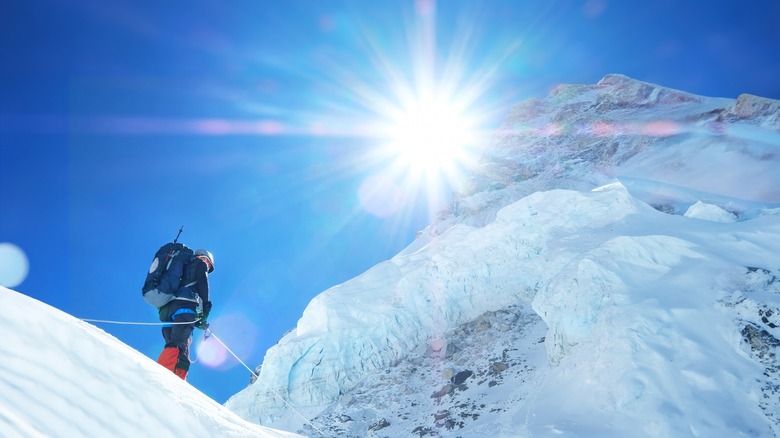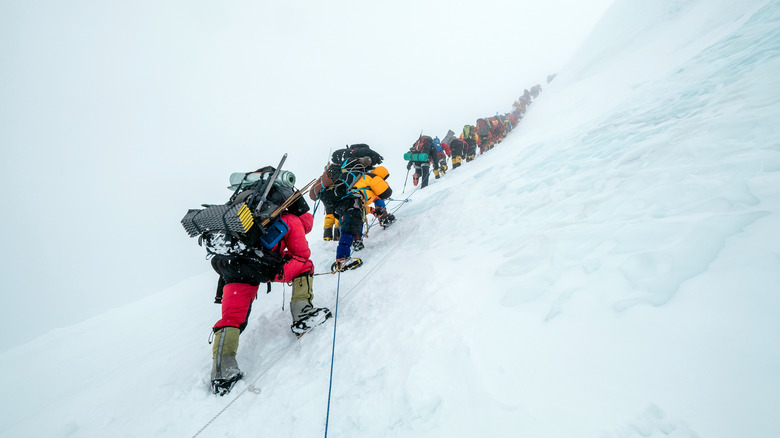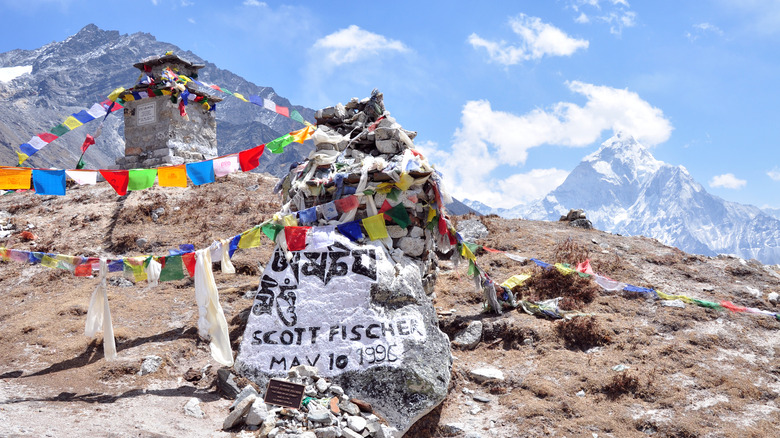The Must-Follow Rule Of Climbing Mt. Everest That Could Save Your Life
Climbing Mount Everest, the world's tallest peak, is a feat many adventurers dream of accomplishing. Yet, beyond the romanticized notion of standing at 29,032 feet lies one of the most perilous environments on the planet. Around 300 people have perished while trying to climb this mountain since 1992, and 200 bodies still remain in what is called Everest's open-air graveyard. One survival strategy climbers must adhere to is the "two o'clock rule" — a guideline that could mean the difference between life and death.
The two o'clock rule is a widely accepted safety practice among mountaineers attempting to summit Everest. The rule dictates that climbers should aim to reach the summit by 2:00 p.m. at the latest. If they fail to reach the top by this time — too bad — they are strongly advised to turn back, regardless of how close they are to the summit. Why is 2:00 p.m. the cut off? Because timing is everything on Everest, and making it to the summit is only half the battle.
The descent is usually where the most dangerous conditions arise, and climbers must ensure they have enough daylight, energy, and resources to safely make their way down before nightfall and severe weather sets in. In the springtime (between March and May) — the best time of the year to climb this mountain — the sun sets at 6:00 p.m. It takes between nine and 18 hours for the round trip from Camp Four to the summit; to achieve this, you have to wake up very early, sometimes in the middle of the night at 2:00 a.m., to complete the journey in time. Climbing Mount Everest is no walk in the park!
Why timing is critical on Everest
Everest is notorious for its unpredictable weather, particularly during the late afternoon and evening. As the day progresses, temperatures plummet (nighttime chills of minus 90 degrees Fahrenheit), winds intensify, and visibility can vanish in a matter of minutes, causing potential snow blindness. In these conditions, even the most experienced climbers can become disoriented, exhausted, and at risk of frostbite or hypothermia. Mount Everest is, after all, considered one of the most difficult mountains to climb in the world for a reason.
As climbers ascend Everest, they enter what is known as the "death zone" — the area above 26,000 feet (like the cruising altitude of a plane) where the air is so thin that the human body cannot survive without supplemental oxygen. The mountain literally kills you, slowly. To put it into perspective, without supplemental oxygen, if you were to just sit at the top of Everest, you would feel like you've just run a non-stop 100-yard sprint at maximum speed. With less oxygen saturation in the blood's hemoglobin, every minute spent in the death zone depletes a climber's strength and mental clarity.
Despite modern advancements in climbing gear, weather forecasting, and logistical improvements since the days of the first few who climbed Everest, the two o'clock rule remains as relevant today as ever. It underscores a fundamental principle of mountaineering: The mountain is in control, and climbers must respect it (which also means not contributing to its unsettling poop problem). Mount Everest is a holy mountain for Nepalese Buddhists and Hindus, and in Tibetan, it is called "Chomolungma," or "Mother Goddess of the World." For any climber, the lesson is clear: Knowing when to turn back is one of the most critical decisions you'll ever make.
The dangers of pushing to the summit
Unfortunately, not everyone heeds this warning. 1996 was one of the worst years in Everest's history. Between May 10 and 11, several expeditions, led by experienced guides Rob Hall and Scott Fischer, attempted to summit on the same day, causing traffic jams and delays, especially at critical points in the route. Many climbers reached the summit much later than the recommended turnaround time of 2:00 p.m., with some arriving as late as 4:00 p.m. A sudden blizzard struck that afternoon, bringing violent winds, freezing temperatures, and zero visibility. Climbers who were still descending were caught in the storm and became stranded in the Death Zone, unable to descend. Eight climbers died in this disaster. Some of their bodies still remain on the mountain, like Green Boots (Tsewang Paljor), Rob Hall, and Scott Fischer. The tragedy was chronicled in Jon Krakauer's bestselling book "Into Thin Air" and adapted into the 2015 film "Everest."
For many climbers, turning around so close to the summit feels like an unbearable decision. After years of preparation, financial investment (depending on the route and the guiding company, it costs between $35,000 to $90,000 to climb Everest), and the physical strain of the climb, the desire to stand at the top of the world is overwhelming. But, the mountain is indifferent to human ambition. The harsh reality is that most accidents on Mount Everest happen during the descent — climbers are tired, low on oxygen, and they let their guard down — and pushing your limits to reach the top when you should really turn back greatly increases the risk. Those who follow the rules are the ones who reach a successful summit, make it back down to tell the tale, and come back to climb another day.


